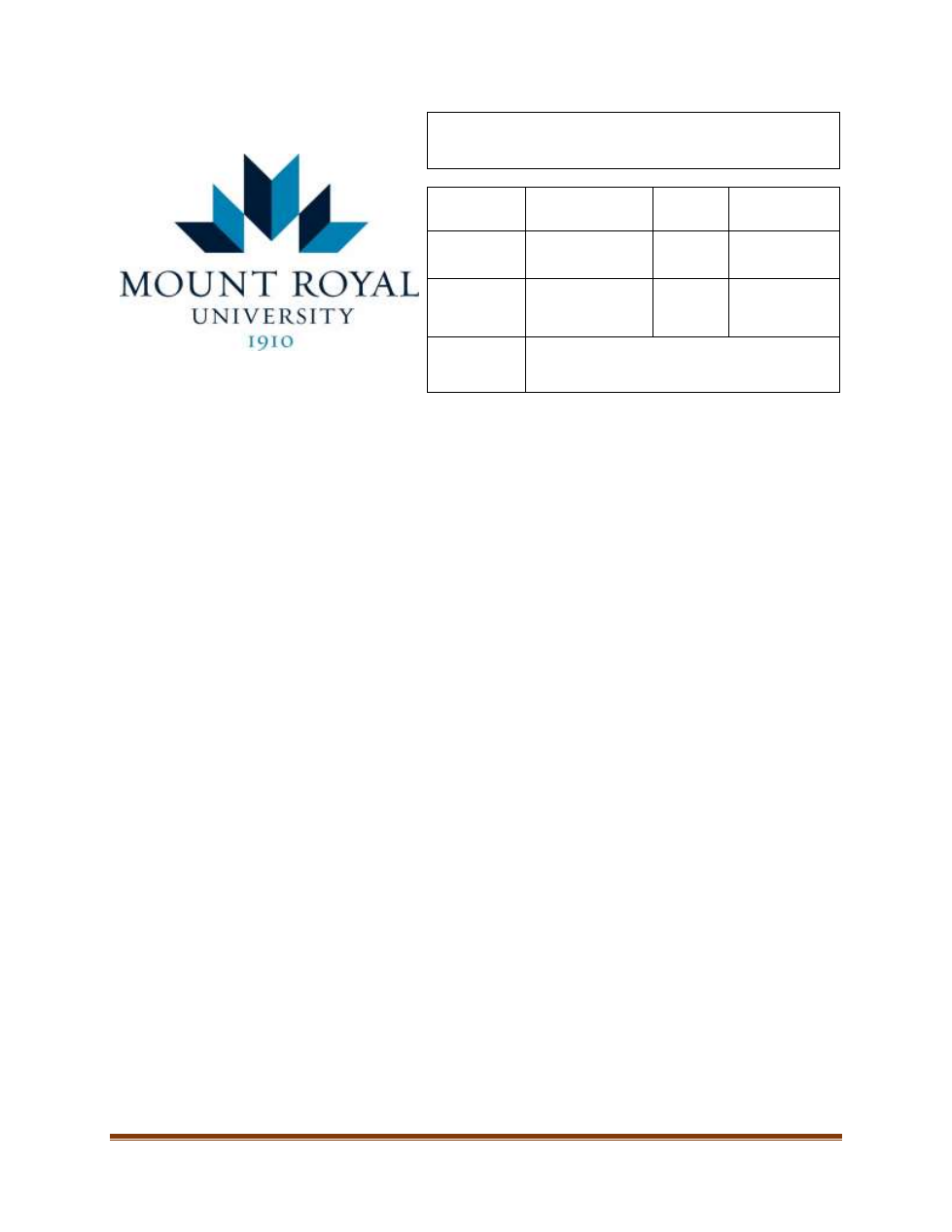
Commercialization of Intellectual Property Policy – May 31, 2010
Page 1 of 4
COMMERCIALIZATION OF INTELLECTUAL
PROPERTY POLICY
Policy Type:
Management
Initially
Approved:
May 31, 2010
Policy
Sponsor:
Provost and Vice-
President,
Academic
Last
Revised:
May 31, 2010
Primary
Contact:
AVP, Research,
Scholarship and
Community
Engagement
Review
Scheduled:
April 1, 2025
Approver:
Board of Governors
A.
OVERVIEW
Mount Royal’s research mission differs fundamentally from those of research-intensive universities.
Our focus on teaching and learning leads to an overall valuation of research that pays particular
attention to its impact on learning. In most Faculties, the potential for commercialization of research
products is not a criteria for evaluation, and therefore, the institutional focus is not specifically on
commercialization or revenue generation.
As Mount Royal relies primarily on public funds and manages a variety of such funds for research
purposes, we have a responsibility to prioritize public benefit over private and to steward public
funds responsibly. Therefore, when Commercialization of research results becomes a possibility,
the University seeks to both recover the money invested and provide a revenue stream in a manner
that underlines our mission and discourages the use of public funds as venture capital.
B.
PURPOSE
To clearly define the obligations of Intellectual Property Creators and the University in regards to
the Commercialization of Intellectual Property.
C.
SCOPE
This Policy applies to all Academic Members who develop Intellectual Property (IP) through the
use of Specialized University Resources and wish to engage in Commercialization of that IP.
D.
POLICY STATEMENT
1.
GENERAL
1.1.
The Creator(s) of Intellectual Property have the exclusive authority to decide
whether to pursue Commercialization of their IP.
1.2.
When Creator(s) elect to Commercialize the IP, they assume responsibility for
legally protecting and marketing it, finding a licensee, buyer or partner, negotiating

Commercialization of Intellectual Property Policy – May 31, 2010
Page 2 of 4
an agreement with such third party, and administering that agreement. Any such
agreement must contain full and complete releases and indemnification in favour
of the University, with respect to the commercialized Intellectual Property.
Concurrently with entering into any type of agreement whereby the Creator(s) will
earn revenue, the Creator(s) shall enter into an agreement with the University,
which shall establish the University’s share of the Gross Revenue generated by
such commercialization. At minimum, the Creator(s) will pay the University at least
10% of Gross Revenues arising from the Intellectual Property, on an annual basis.
The University shall provide the Creator(s) with a template agreement that will form
the basis for the contractual arrangement between the University and the
Creator(s).
1.3.
Any such Intellectual Property is further subject to the license and other rights of
the University under the Intellectual Property Policy.
1.4.
In exceptional circumstances where the Creator makes a clear case that payment
of 10% of Gross Revenues would considerably reduce the viability of the
Commercialization activity, the Board of Governors of Mount Royal University may
consider modifications to this percentage.
1.5.
Where the Academic Member and the University are co-owners of an IP and where
the University has not waived its ownership rights, then the University’s Provost
and Vice-President, Academic or designate shall represent the University’s
interest in all matters related to this IP, including but not limited to patents, sale,
licensing or any other Commercialization activity.
1.6
The University is not responsible for any legal, development, marketing and other
costs the Creator(s) may incur, including patent prosecutions.
2.
TIMELY DISCLOSURE
2.1
Academic Members who have developed Intellectual Property that they intend to
Commercialize must inform the Associate Vice-President Research, Scholarship
and Community Engagement in advance, in writing, and in a timely way of their
intentions. Such disclosure must include the nature of the IP, the names of all co-
creators, the source of funding for the research project out of which the IP
emerged, and any other information requested by the University. This disclosure
shall remain confidential.
2.2
At the time of disclosure the determination of what constitutes Specialized
University Resources in a particular context shall be made, in writing, and signed
by the Creator and the Dean/Director of the relevant Faculty/Unit. Otherwise, the
Dean/Director shall make the determination.
3.3
Any resulting revenue sharing agreements will be disclosed by the Associate Vice-
President, Research, Scholarship and Community Engagement in a confidential
report to the Board of Governors on a quarterly basis.
E.
DEFINITIONS
In this Policy, the following terms, when capitalized, shall have the following meanings:
(1)
Academic Members: shall include full-time and part-time instructors teaching credit
courses, any other person teaching a credit course,

Commercialization of Intellectual Property Policy – May 31, 2010
Page 3 of 4
counsellors, educational developers, librarians, those persons
from time to time designated “Academic Members” by the
Board, and any other person teaching non-credit courses. It
shall also include teaching assistants, post-doctoral fellows,
research fellows, undergraduates and other students.
(2)
Board/Board of
Governors:
means the Board of Governors of Mount Royal University
(3)
Commercialization: shall mean activities undertaken in order to exploit Intellectual
Property. Commercialization includes assignment, licensing,
manufacturing or production of Intellectual Property with the
goal of financial return
(4)
Creator:
shall mean the person or persons who create Intellectual
Property
(5)
Gross Revenue:
shall mean the proceeds from the sale, lease, transfer,
assignment, license, grant of right of access, or other
conveyance or grant of rights in respect of intellectual property
or intellectual property rights therein, including without
limitation, any license issue fees, option fees, royalties, and
equity interests, except that any equity interests, or portion
thereof received by the University shall not be included in
“Gross Revenue” unless and until such time as the equity
interests, or portion thereof, are sold by the University. The
gross revenue in a transaction between affiliated parties, or
any parties that are otherwise associated with each other or
acting in concert, or in any other non-arm’s length transaction,
will be the greater of: (i) the actual amount paid, and (ii) the
amount that would have been paid in a similar transaction at
arm’s length.
(6)
Intellectual Property
or IP:
shall mean any result of intellectual or artistic activity created
by a person, that can be owned by that person including but
not limited to: works, data, inventions, ideas, patents, patent
applications, industrial designs, trade-marks, trade names,
domain names, integrated circuit topographies, plant varieties,
computer programs, circuits, biological material, chemical or
other compositions of matter, know-how, confidential
information and trade secrets, which can be registered or
otherwise protected under the law.
(7)
Policy:
means the Commercialization of Intellectual Property Policy
(8)
Specialized
University
Resources:
shall mean University Resources that would not normally be
utilized by the individual in the normal course of duties and
would require University funding either directly or indirectly.
Examples include, but are not limited to, MRU funded grants
for the project in excess of $10,000, scientific instrumentation,
specialized library resources or personnel, additional teaching
release for faculty, or the use of research labs. External
funding may be included, depending on the nature of the
contract, awards agreement, or funding agency policy.
Examples of resources that do not apply include the portion of

Commercialization of Intellectual Property Policy – May 31, 2010
Page 4 of 4
a standard faculty workload dedicated to research, use of an
office computer, or hiring research assistants using grant
funds. The determination of what constitutes Specialized
University Resources in a particular context shall be made, in
writing, at the outset of commercialization activities, and
signed by the Creator and the Dean/Director of the relevant
Faculty/Unit. Otherwise, the Dean/Director shall make the
determination. Such a determination is subject to the dispute
resolution process set out in the Intellectual Property
Procedures.
(9)
University:
means Mount Royal University
(10)
University
Resources:
shall include the use of University funds, University staff,
facilities, equipment, materials, technological information, or
proprietary know-how.
F.
RELATED POLICIES
•
Intellectual Property Policy
H.
RELATED DOCUMENTS
•
Intellectual Property Procedures
I.
REVISION HISTORY
Date
(mm/dd/yyyy)
Description of
Change
Sections
Person who
Entered Revision
(Position Title)
Person who
Authorized
Revision
(Position Title)
05/31/2010
NEW
01/22/2020
Editorial
Template Update
Policy Specialist
University Secretary



